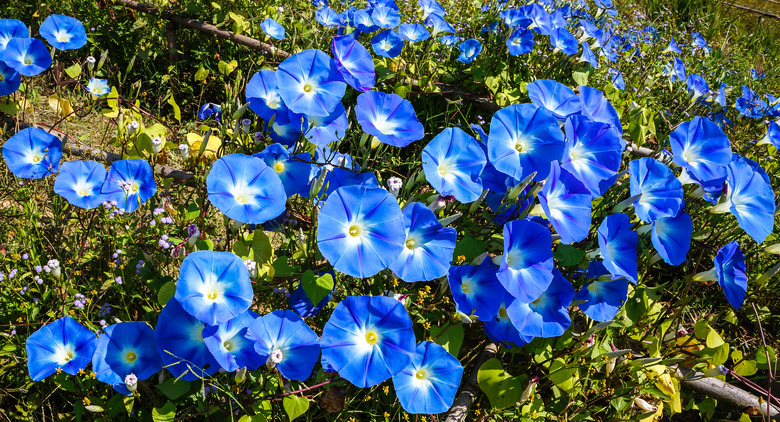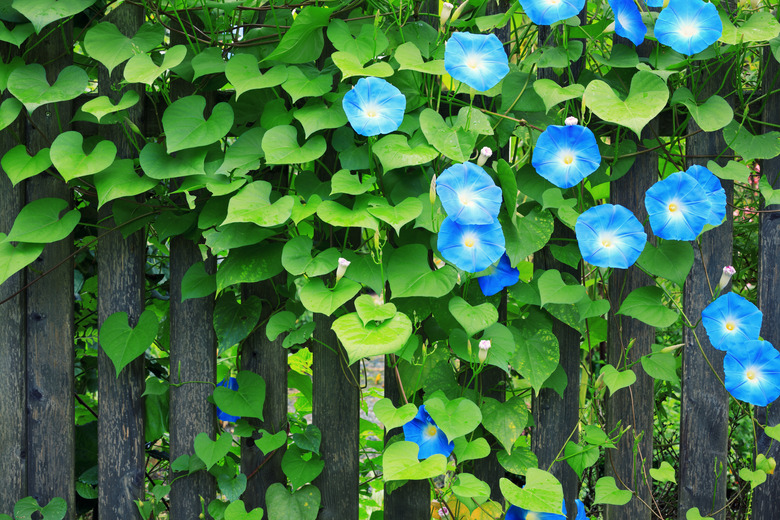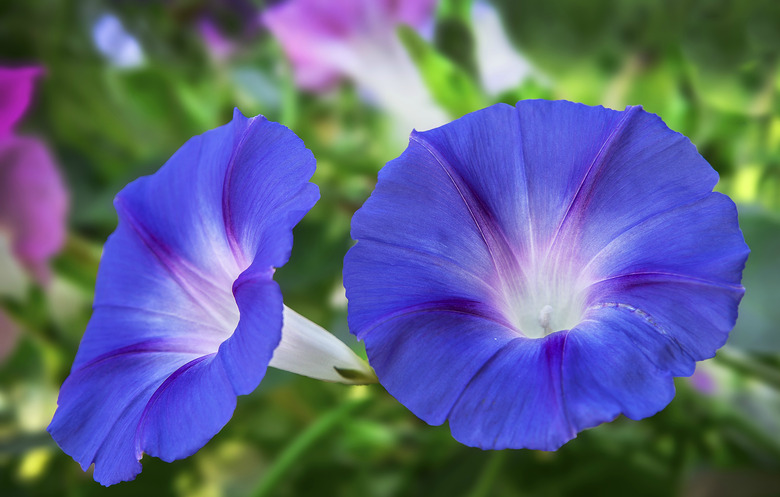How To Grow Morning Glories
We may receive a commission on purchases made from links.
Even if you're not a morning person, you may find morning glories (Ipomoea spp.) worth getting out of bed. The heart-shaped leaves of this vining annual are attractive, but the real show stoppers are the trumpet-shaped flowers that sprout every morning only to wilt away each afternoon. These stunning blooms appear in shades of blue, purple, pink, and white and put on quite a show every day from spring until fall, typically blooming from May through September or October.
Most morning glory plants only last one season in most areas, but they make the most of their time. They grow very quickly and can easily reach heights of 10 to 15 feet by late summer if you give them something to climb. If not, their long tendrils will knot together on the ground and form a thick, dense ground cover instead.
As beautiful as morning glories may be, responsible gardeners will note that they're not welcome everywhere. Because they spread and self-seed prolifically, they're considered invasive plants in many locations, including Maryland, Kentucky, Georgia, and Florida. And it's even illegal to grow morning glories in Arizona.
Best Uses for Morning Glories
Best Uses for Morning Glories
Morning glory flowers are as useful as they are beautiful. The vines look great growing over a trellis or onto a fence, and they can also hide the less-attractive parts of your garden. Planting them in front of an ugly shed wall, for example, is a great way to hide the eyesore.
Rather than letting them grow up, some gardeners leave morning glory vines to travel across the landscape. This is an excellent way to cover a large bare patch quickly. You can also plant morning glory on hillsides or in hard-to-mow places. To permanently cover these patches, plant morning glories alongside perennials for a few seasons until the perennials grow large enough to make the morning glory unnecessary.
Morning glories will grow in a container, and many gardeners enjoy using them in hanging baskets. The plant's long tendrils will stretch toward the ground and spill over the pot, creating a cascade effect. Proving they're more than just pretty faces, morning glories will also prove useful in attracting butterflies, hummingbirds, and other pollinators to your garden.
Note that you should use morning glories only to beautify outdoor spaces. Historically, herbalists brewed tea from the plant's flower or roots to use as a diuretic or an expectorant. Some used it as a headache cure as well. Because they contain a chemical similar to LSD, some American Indians chewed the seeds to go into ritualistic trances.
We now know that morning glory seeds are poisonous and that it's best to avoid ingesting the plant. If your crunchy aunt pops by for tea and sees your morning glories, don't let her convince you that the plant is a natural cure for anything.
How to Grow Morning Glories
How to Grow Morning Glories
Starting Morning Glories From Seed
Starting Morning Glories From Seed
Morning glories grow readily from seeds, so much so that plants left unchecked will reseed themselves. They don't, however, do well with transplanting. As such, it's best to sow morning glory plant seeds directly in the garden. If you want to start your seeds indoors, do so four to six weeks before the last frost in your area and start the seeds in biodegradable pots so you don't need to disturb the roots when planting them.
Because they're not particular about the soil in which they grow, you can skip the soil preparation for morning glories. You can work a bit of compost into the soil before planting if you like just to loosen heavy soil, but this isn't truly necessary when planting morning glories in most types of soil.
Before planting, scratch your seed with a nail file to penetrate the thick outer coating. After filing, soak your seeds in water for 24 hours to soften them. Sow the prepared seeds about 1/4 inch deep, spacing them 6 inches apart. Water your seeds after planting and keep a watchful eye on them. Germination takes approximately about a week. Once they've grown to about 6 inches in height, make sure you give them a trellis or some type of support on which to climb.
Morning glory seeds are toxic. Until you can plant them, make sure you keep your seeds where children and pets can't get to them.
In What Zone Do Morning Glories Grow Best?
In What Zone Do Morning Glories Grow Best?
Morning glory plants can and will flourish as an annual anywhere in USDA plant hardiness zones 3 through 11. In areas where the winter temperatures drop below 45 degrees Fahrenheit, morning glory is an annual plant.
In areas where the temperature stays above 45 degrees, however, morning glories act as perennials. Gardeners in zone 9 and above can usually count on their morning glories to come back in the spring. In tropical areas, morning glory will flower year-round and may be evergreen.
When Should You Plant Morning Glories?
When Should You Plant Morning Glories?
Sow your morning glory seeds as soon as the soil temperature warms to about 65 degrees. This is usually about two weeks after your last frost date. In zones 3 through 5, that usually means sowing in May. You may be able to start the seeds as early as January or February in zone 9 and warmer.
Soil, Sunlight, and Water Recommendations for Morning Glories
Soil, Sunlight, and Water Recommendations for Morning Glories
Morning glories are happy-go-lucky plants that don't demand much. They prefer loamy or sandy soils but will grow just about anywhere. They need lots of sunlight, and despite their drought tolerance, they grow best when watered once or twice a week. If you wish, you can fertilize your vines at the beginning of the growing season with a balanced 10-10-10 fertilizer, but don't overdo it.
People mistakenly believe that plants flower when they're happy, but that's not always the case. Flowers hold seeds that plants use to reproduce. For many plants, receiving the very best of everything means there's no fear of dying and no need to waste resources and energy growing flowers. It's only when these plants are slightly stressed that they feel the need to go through the flowering and reproductive process. If you're too attentive, plants sometimes forgo flowering.
Morning glories easily grow around trellises and fences, but they don't stick to them like ivies. If you don't want your morning glory to heap on the ground, make sure you provide adequate trellises for your plant to climb. The thinner the support you provide, the faster the morning glory vine will cover it.
When planning your garden, remember that morning glories don't always play well with others. They can pair nicely with mature annuals that can hold their own, but they'll easily overgrow young perennials and other annual plants.
Morning glories will prolifically reseed themselves if you let them. If you don't want more plants, snip spent flower buds off the plants before they go to seed. If you lack the time to do this, you can simply pluck unwanted morning glory seedlings before they get too big.
You can also remove unwanted plants by thoroughly raking the garden and removing any plant growth when the growing season is over. Do this when you pull down your morning glory vines after the season's first killing frost.
Common Pests and Other Problems for Morning Glories
Common Pests and Other Problems for Morning Glories
Both morning glories and spider mites like hot, dry weather, so you'll often find the two together. Signs of spider mites include tiny webs that look like spider webs, white dots on your plant's leaves and yellowing leaves. Fortunately, spider mites are easy to treat with an insecticidal soap.
You may also see Japanese beetles or aphids on your plants. Even if you don't see the insects themselves, skeletonized leaves are a telltale sign of beetles, while a sticky residue on your leaves indicates aphids. You can pick Japanese beetles off your plants by hand when you see them and shoot off aphids with water from your garden hose. If you're dealing with a severe infestation, the insecticidal soap can again save the day.
You may also notice leaf miners on your morning glory plant or find the little silver tunnels they leave behind in plant leaves. Fortunately, leaf miners aren't a major problem and don't require any treatment. Any issues they cause are purely cosmetic and won't impact the health of your plants.
Common Diseases for Morning Glories
Common Diseases for Morning Glories
Morning glories are susceptible to a handful of diseases, but sometimes, you may be dealing with something much simpler. If the leaves of your morning glory turn yellow, the plant is probably getting too little sunlight or the wrong amount of water. Take a look around and make sure your plants are getting lots of sunlight. If not, you may have to move them or trim back the plants that are shading your morning glories.
Watering can also be a problem. Morning glories are pretty drought-resistant, so it's more likely that your plant is getting too much water than not enough. Check the soil around your plant and let it dry out completely before watering it again. If too much water is the issue, your plant will perk up again in a few days when it dries out a bit.
Because they're such dense and bushy plants, morning glories are susceptible to fungal infections. To reduce the risk of these issues, direct water at the base of your morning glory plants rather than wetting the leaves, and keep the area around the plant free of leaves, weeds, and other debris. Remove any leaves infected by fungal infections, such as rust or powdery mildew, and treat the plant with a fungicide.
Morning glories also sometimes experience canker. This disease hollows out the stems of your plant, creating areas where the vine will turn brown and collapse in on itself. It starts by wilting the tips of the plants' leaves and then moves inward to the stem. There's no cure for many types of canker, so cut away and dispose of infected tendrils.


